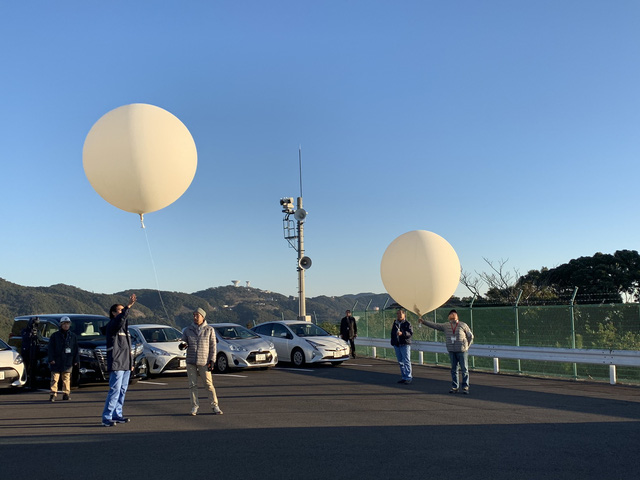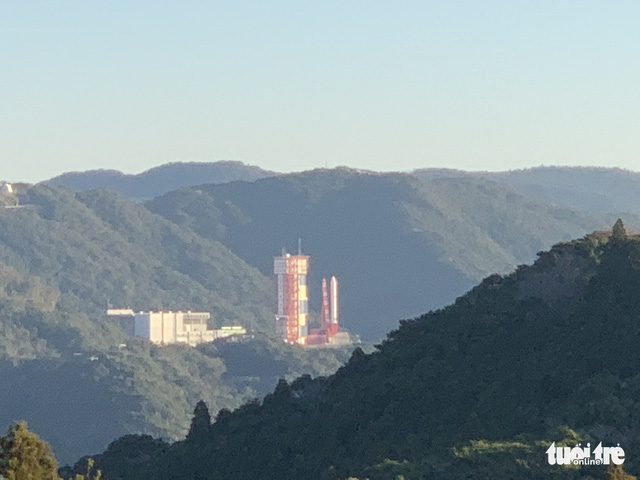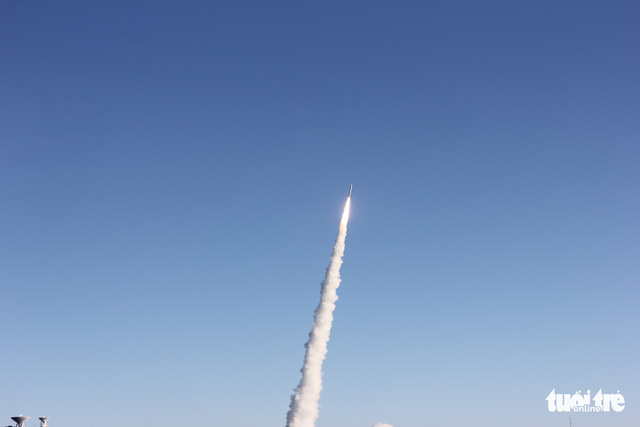A Vietnam-made miniaturized satellite designed to track ocean quality was launched into orbit Friday morning from Japan.
A Tuoi Tre (Youth) newspaper journalist was present to report the event.
It was all blue skies and sun in southern Japan as scientists and aerospace experts gathered four hours before the launch at the Uchinoura Space Center, Japan’s largest space launch complex, located on Kyushu – one of the country’s largest islands.
Only around 100 visitors were allowed to watch the moment.
Prior to the rocket launch, the space center released three high-altitude balloons to measure weather parameters in the troposphere, the Earth’s lowest atmosphere layer at about 13 kilometers above sea level.
 |
| Technicians from the Japan Aerospace Exploration Agency launch weather balloons before Epsilon-4 departs the Uchinoura Space Center in southern Japan, January 18, 2019. Photo: Thanh Ha / Tuoi Tre |
 |
| Epsilon-4 is seen at the Uchinoura Space Center in southern Japan, January 18, 2019. Photo: Thanh Ha / Tuoi Tre |
At 9:51 am local time, the Japanese Epsilon-4 rocket, carrying Vietnam’s 50-kilogram MicroDragon, lifted off the platform.
MicroDragon was planned to be ejected 511 kilometers above ground at the lightning velocity of 7.6 kilometers per second at 10:56 am, according to the Japan Aerospace Exploration Agency (JAXA).
The agency said the departure was successful.
The satellite is expected to send the first signal to a Tokyo-based ground station less than 24 hours after launch.
 |
| Epsilon-4 leaves the Uchinoura Space Center in southern Japan, January 18, 2019. Photo: Thanh Ha / Tuoi Tre |
 |
| Epsilon-4 leaves the Uchinoura Space Center in southern Japan, January 18, 2019. Photo: Thanh Ha / Tuoi Tre |
In addition to MicroDragon, the rocket carried six other satellites produced by Japanese organizations.
They consisted of the Japan Aerospace Exploration Agency’s 200-kilogram RAPIS-1; Tohoku University’s 60-kilogram RISESAT; Tokyo-based space firm ALE’s 68-kilogram ALE-1; Tokyo Institute of Technology’s four-kilogram OrigamiSat-1; Kyushu Institute of Technology’s three-kilogram Aoba VELOX-IV; and Nihon University’s one-kilogram NEXUS.
MicroDragon is a satellite that can be considered ‘made by Vietnam’ as its creators are 36 young Vietnamese people who have studied at Japan’s top five higher education institutions, which are the University of Tokyo, Keio University, Hokkaido University, Tohoku University and Kyushu Institute of Technology.
 |
| Vietnamese engineers install MicroDragon. Photo: Vietnam National Space Center |
 |
| Engineers weigh MicroDragon. Photo: The Japan Aerospace Exploration Agency |
It is intended to monitor the coastal seawater to facilitate Vietnam’s fish farming industry and its production process.
It also allowed Vietnamese engineers to gain experience in designing satellites of its type, according to Pham Anh Tuan, director of Vietnam National Space Center (VNSC).
The microsatellite’s imagery will become part of an international database and this is expected to improve response to natural disasters and climate change, Tuan underlined.
The photographs it provides will also be utilized together with the available observation imagery in the world to find new applications or improve known applications of microsatellites weighing between 10 and 100 kilograms.
VNSC experts are being trained in Japan for the processing of MicroDragon’s signal and its imagery.
 |
| Engineers pose for a picture with MicroDragon before it is transported to Japan’s Uchinoura Space Center, December 19, 2018. Photo: University of Tokyo |
 |
| Engineers from the Japan Aerospace Exploration Agency (JAXA) fix a satellite to a rocket frame. Photo: JAXA |
The space center had a one-kilogram PicoDragon put into orbit in 2013 and is planning to create a larger satellite by 2021.
Vietnam currently has six satellites in space: Vinasat-1, Vinsat-2, F-1, VNREDSat-1, PicoDragon, and most recently MicroDragon.
Epsilon-4, which transports MicroDragon, belongs to a group of Japanese solid-propellant launch vehicles called Epsilon.
Epsilon’s maiden launch was the Epsilon-1 in 2013.
 |
| Artificial satellites are seen attached to Epsilon in this photo taken from JAXA. |
 |
| An Epsilon launch rocket is seen in this photo taken from the Japan Aerospace Exploration Agency. |
 |
| Vietnam National Space Center’s satellite plan over the years. Photo: Vietnam National Space Center |
 |
| The Uchinoura Space Center is seen in this aerial picture taken from its website. |
 |
| The Uchinoura Space Center is seen in this picture taken from its website. |
Like us on Facebook or follow us on Twitter to get the latest news about Vietnam!













































